I still remember my first taste of artificial intelligence (AI).It was “SmarterChild,” a chatbot available on AOL Instant Messenger (AIM) and Windows Live Messenger in the early 2000s that you could have a “conversation” with when your real friends weren’t online.
But honestly, even as a preteen, I could see that it needed a lesson in humanizing AI content.
While SmarterChild could ask how I was and tell jokes, the exchanges felt, well, robotic. It couldn’t learn or remember information over time, and it had trouble navigating human quirks like slang and shorthand. It also seemed to always throw out the same canned phrases, like it was the star in an ‘80s sitcom.
Thankfully, much of this has improved today, but the challenges (and importance) of capturing human candor and understanding remain — especially for marketers.
Let’s unpack how to maintain your human touch while still reaping the benefits of AI content as a marketer.
Table of Contents
The Rise of AI Content
According to Pew Research, 55% of Americans use AI at least once a day.
It’s running our wearable fitness trackers and curating our Daily Mixes on Spotify. It’s giving us product recommendations on Amazon and sending those pesky emails we never read to the spam folder. And the impact doesn’t stop there.
HubSpot’s State of AI found that 62% of business leaders say their company invests in AI and automation tools for employees.
In fact, the number of marketers who use AI in their roles has jumped from 21% to 74% year over year, with more than 74% believing most people will use AI in the workplace by 2030.
But why exactly?
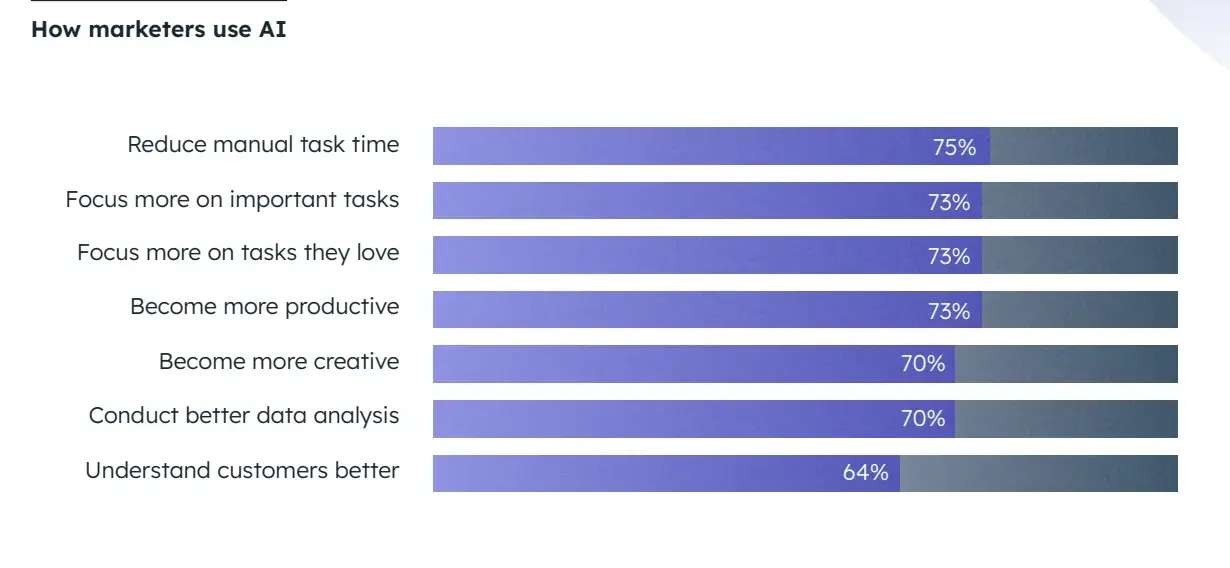
Simply put, AI can help people in various industries automate or expedite repetitive tasks (e.g., email automation), increase efficiency, lower costs, improve analysis, and be more productive overall — especially marketers.
So, should you use AI content?
The short answer is yes — but I say this with many asterisks. Let me explain.
As a writer and marketer, I pride myself on being able to spin up copy that converts, emails that engage, and blog articles that get readers nodding their heads. But that doesn’t mean it comes quickly or easily.
Keeping up with a full marketing calendar is hard. Every piece of content has a workflow that includes planning, research, writing, editing, staging, promotion, and analyzing.
AI content can help expedite this process, with 83% of marketers saying AI helps them create significantly more content than they could without.
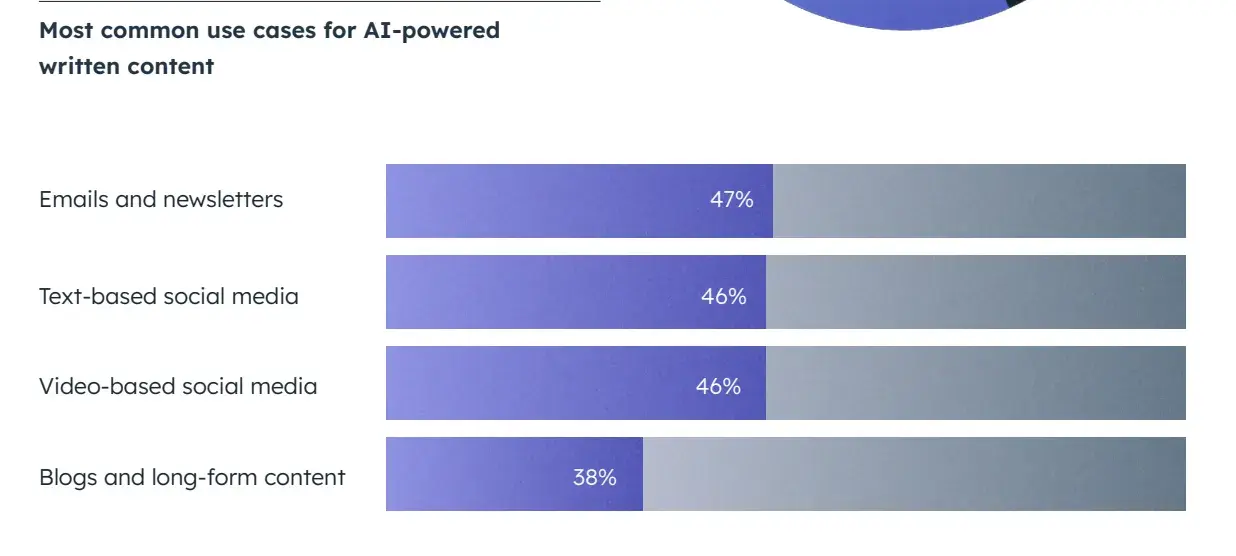
What kind of content are marketers generating? Check out The Top Types of AI-Generated Content in Marketing [New Data, Examples & Tips].
A good friend, former HubSpotter, and Head of Content at Ashby, Anum Hussain, agrees, saying, “I‘m not sure I’ll ever see AI go from 0 to 100 on a content initiative, but for all of us who face empty page syndrome, getting from 0 to 50 is a huge productivity unlock.”
But that doesn’t mean you can just mindlessly copy-paste whatever ChatGPT, Claude, or even HubSpot’s Breeze gives you. It needs to be edited and “humanized.”
Why does AI content need humanization?
Our research shows that 86% of marketers using AI take time to edit the content it produces. (And I can’t tell you how much of a sigh of relief it was to read this.)
Despite the operational positives we discussed, AI is plagued by concerns about plagiarism, bias, data security, and the potential for government regulation. In other words, raw AI content can be very problematic as it is derivative by nature.
You see, AI content generators are built on existing content commonly gathered from the Internet. This is how they “learn.” Every time you enter a prompt or query into a tool, AI simply reaches into this knowledge bank and picks out what it thinks is most relevant to what you want.
That means it just compiles things already out there. There’s no guarantee that your results will be different from what the tool produces for another user or even from what’s already published online.
It also certainly won’t be written with your brand’s voice or differentiators in mind, or offer the expertise, experience, authoritativeness, or trustworthiness (EEAT) Google SERP demands of the pages it ranks.
Smart editing or taking the time to humanize your content can put all these concerns to rest. So, how do you do it?
How to Humanize AI Content
Whether you’re a social media manager writing captions or a content manager writing articles and website copy, learning how to humanize AI content is critical to future-proofing your content strategy. Here are seven tips on how to do it well.
To help illustrate them, I asked ChatGPT to write me a blog article about how to write a great social media post.
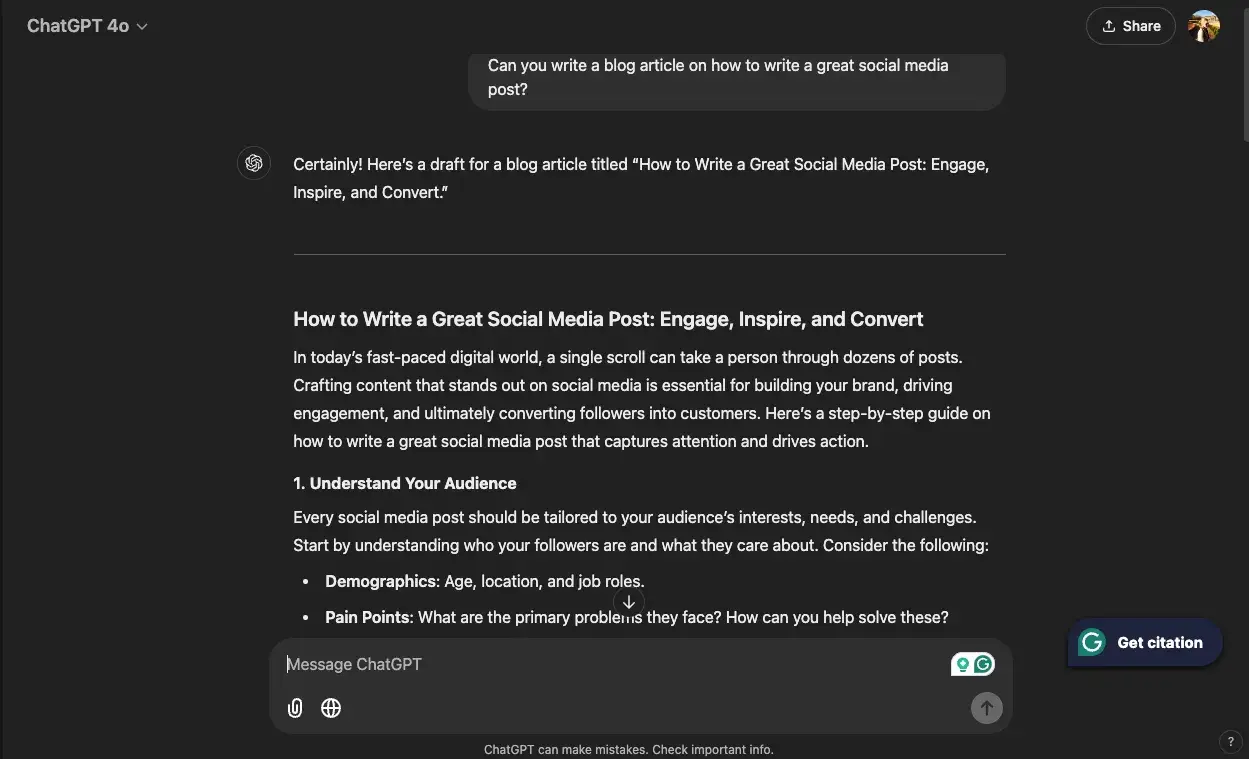
1. Add personal stories and insights.
AI knows many things, but you know what it doesn’t? Your personal thoughts, insights, and experiences.
When you ask it to create content for you, it may respond in a casual tone, but it’s likely just stating facts — like a textbook or instruction manual.
That said, personal stories, references, or lessons can not only engage your audience with something relatable, but they add depth and originality to your content. It's all about thought leadership.
Melanie Deziel, Content Consultant and Co-Founder & Chief Learning Officer of Creator Kitchen likes to share both personal wins and losses when editing AI content.
She shared with me, "We can take the raw materials we get from a tool like ChatGPT and infuse not just valuable lessons we've learned but also relatable mistakes we made along the way. We can add context to our revelations, realizations, failures, and pivots by sharing the emotions that surround those experiences."
Let’s look at our example. In my sample article, ChatGPT gave me the following for an intro:

Pretty generic, right?
I’d humanize this AI content by bringing in a relatable anecdote about doom scrolling when I can’t sleep or talking about a successful social media strategy I’ve worked on to establish credibility. I could also add a section on the current state of social media with my own predictions and opinions.
ChatGPT laid a foundation, but all of these personal touches would give it flair. Something they can’t get anywhere else.
Pro tip: Have fun with it!
Deziel continued, "While ChatGPT's LLM may have a good handle on the prescriptive rules of grammar and syntax, we have to know when and how to break those rules for maximum impact.
"We can include puns, sarcasm. We can make plays on words and include humorous asides (or... asides that we think are humorous, anyway.) We need to intentionally manipulate sentence length with melodic mastery and break the monotony with unexpected word choices."
"We have to get loosey-goosey with our punctuation choices, inserting ellipses to force a breath and peppering our pages with em-dashes to mirror the stop-and-start nature of our chaotic thought patterns... and we say things like 'loosey-goosey.'
In short, we have to do what hasn't been done. And an LLM, by design, cannot. "
2. Incorporate original, visual examples.
Like personal insights, examples give AI content more substance. But they can also make the information shared easier for your audience to understand, especially if it’s educational.
Returning to our sample, ChatGPT listed this as one of its steps for creating a great social media post:
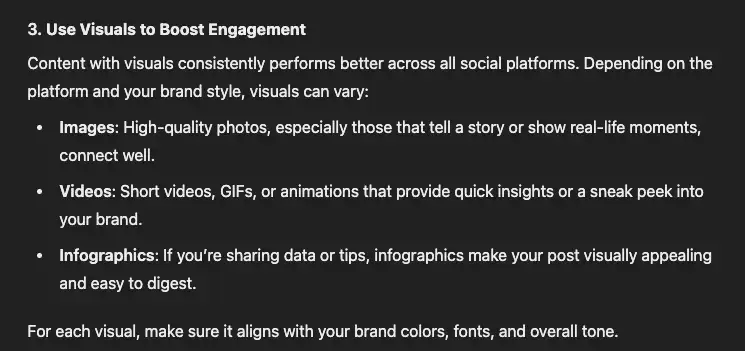
“Use visuals to boost engagement” is pretty self-explanatory, sure, but showing real-life examples where this was done well would really drive the point home. Plus, it would help break up text, making your piece easier to skim and also giving readers something more fun to engage with.
To humanize this section, I’d embed actual social media posts from brands my audience admires and explain why they were successful. This is something I do frequently in my articles:
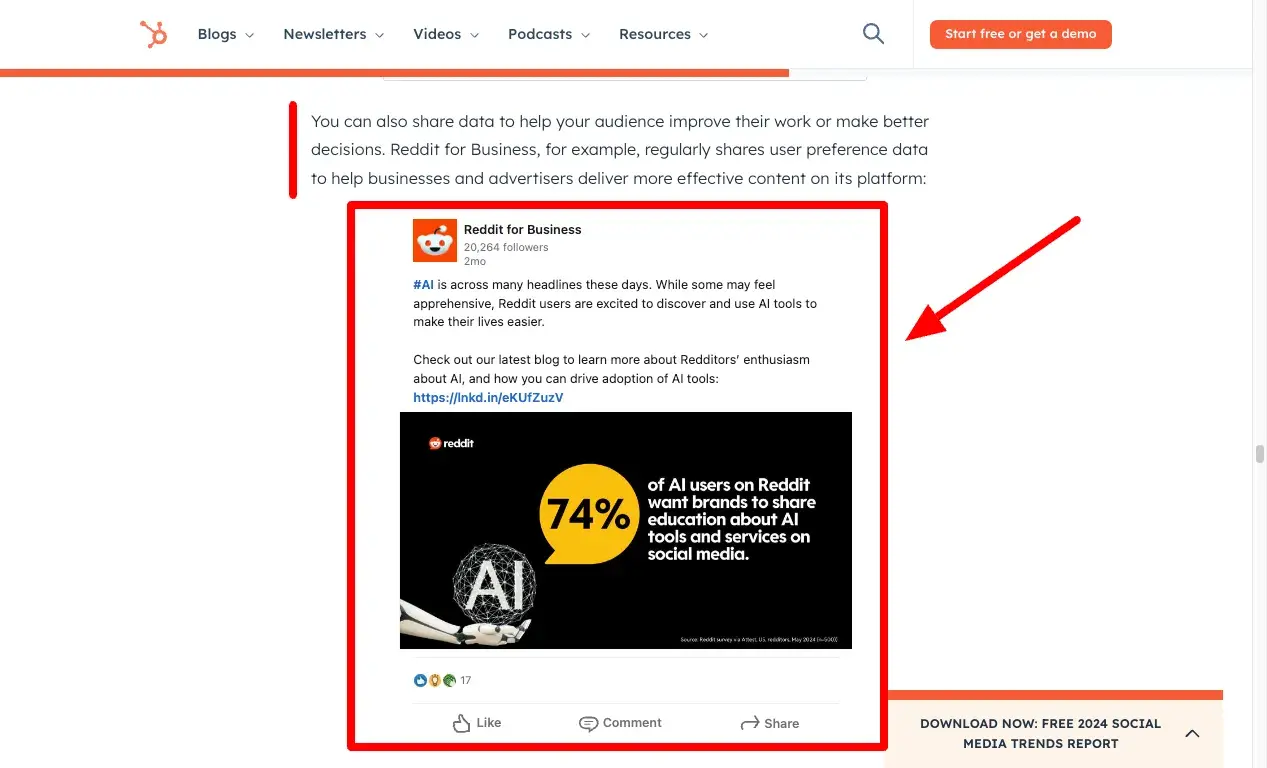
I’d also be careful not to repeat examples included in competing content and be mindful of diversity and inclusion as I made my selection.
The idea here is to avoid the obvious and show my audience something fresh to inspire their own social posts.
Pro tip: Pull examples from your own body of work whenever you can.
Consider your brand’s case studies, testimonials, or portfolio and what can support the content. These examples are unlikely to appear in similar content by your competitors, and, once again, they help showcase your personal expertise on the subject matter.
3. Edit into the first person.
Third-person writing is a tell-tale sign that you used AI.
This style can read as formal, boring, and impersonal, hurting you with Google’s EEAT regulations. To avoid all this, try rewriting your AI content into the first-person perspective — meaning using pronouns like I, me, and we.
My teammate and managing editor of the HubSpot Website Blog, Jamie Juviler, actually turns back to AI to help him do this.
He explains, “Sometimes AI helps me make my writing sound more human. For example, if I have a paragraph written in the third person, I’ll ask ChatGPT to convert it to the first person with minimal changes to the copy itself.”
This saves Juviler a great deal of time, especially since he can use the same tool that generated the content in the first place — no need to hop around other documents or tabs.
Pro tip: Put your title in the first person as well.
Juviler continues, “I also do the same with post titles and email subject lines — run them through ChatGPT and prompt it to make the wording more unique to my voice. Doing this makes readers more likely to engage with the content if the headline is from my perspective, versus a generic title.”
In the case of my social media article, ChatGPT turned “How to Write a Great Social Media Post: Engage, Inspire, and Convert” into:
- “How I Write Engaging Social Media Posts That Inspire and Convert”
- “My Guide to Crafting Social Media Posts That Engage, Inspire, and Convert”
- “How I Create Social Media Posts That Stand Out, Engage, and Drive Results”
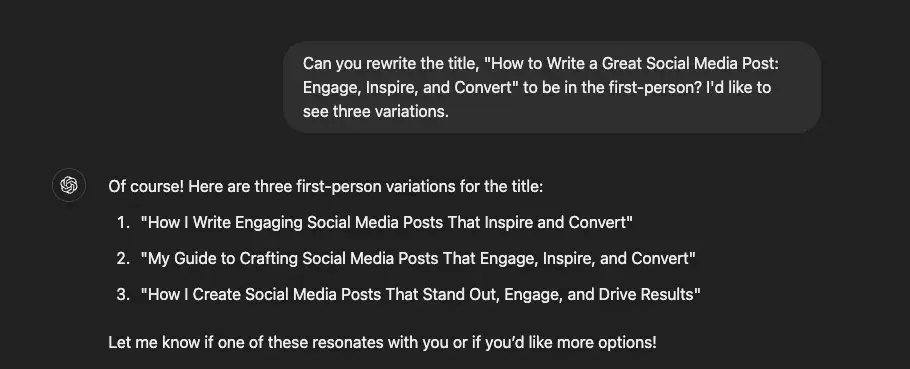
This is also a great hack for brainstorming titles for your editorial calendar. Learn how to create yours.
4. Shift to an active voice.
Along with third-person, AI content generators tend to lean on passive voice. And like my old friend SmarterChild, it sounds extremely robotic.
For example, in my article, ChatGPT passively wrote: “If you’re celebrating a milestone, express excitement. If you’re discussing a tough topic, show empathy.”
This could be more dynamic and engaging if shifted to active voice becoming: “Express excitement when you celebrate a milestone and show empathy when you discuss tough topics.” Review your AI content for these opportunities.
5. Fact check everything.
As we discussed earlier, AI tools pull information from all over the place. Who knows if what it tells you will be credible or up-to-date? In fact, they recognize this.
Why do you think most tools even come with a disclaimer like this one from ChatGPT? “ChatGPT can make mistakes. Check important info.”

Heed their warning, people. Fact-check everything AI writes for you.
That means both quantitative (dates, statistics, etc.) and qualitative facts. Also, be mindful of how old the information is. While a statistic may be true and from a reputable source, it’s likely no longer relevant if it’s from a decade ago.
A quick hunt in a search engine should be all you need to confirm or deny information AI gives you, but you can also try tools like Google’s Fact Check Tools or Longshot to speed up the process.
Pro tip: If you have original data or research, incorporate it. This is another example of information no other competitor or AI will have.
6. Get more specific with your prompts.
Ok, so. So far, all of the advice I’ve shared is reactive. They are things you can do after AI’s generated your content, but there are proactive actions you can do as well.
I can pretty much summarize them all by saying, “Get more specific with your prompts.” But that’s not helpful, so let’s unpack things a bit.
I often compare using AI to working with a freelancer. Whenever you hire a freelance writer, you give them a creative brief of what you’re looking for, right? You don’t expect them to deliver the desired results if they don’t know what you want. The same should go for AI.
Improving your AI writing prompts — telling the tool exactly what you want to see — improves the chances that the results will match your needs and brand voice.
In our conversation, Anum Hussain drove this home, saying, “Ultimately, training AI tools can be similar to new hire onboarding. Providing examples, editing work, and asking for specific edits/changes helps train the tool to work more and more in your style over time."
"At the end of the day, it's a tool, and we are the humans to guide it.”
Here are five key things you can do.
Give AI a persona to adopt.
If you want AI to write in the first person as an expert, you must tell them who they are. In your prompt, include who the author is, what they do, and perhaps even a bit of their experience.
It’s also smart to include details about your brand or business, such as:
- Your product/offering
- What makes it different (specific features, capabilities, etc.)
- Company Mission
- Company Values
This information will help your AI tool better understand the perspective it should adopt when writing.
Describe your audience.
Next, you also need to tell your tool who the audience is. Who are you trying to reach with this content? You can share a full buyer persona with your AI tool if you’d like, but at a minimum, you want to include:
- Age
- Location
- Company, job title, industry (if B2B)
- Goals
- Personal challenges
- Pain points you solve
Describe your brand voice.
How should the content AI creates sound? Should it be friendly? Authoritative? Funny? Detail it in your prompt so the tool can act accordingly.
Read: How to Create a Content Style Guide [+ Free Guide & Examples]
Include examples.
Better than just telling AI what you like, show them. Do you have a certain piece of content that you really admire or would like to emulate? Perhaps there’s a piece that performed well that you’d like to recreate the magic of.
Share them in your prompt. Include links or upload files as inspiration with your prompt. Hussain is a fan of this feature available on ChatGPT Plus.
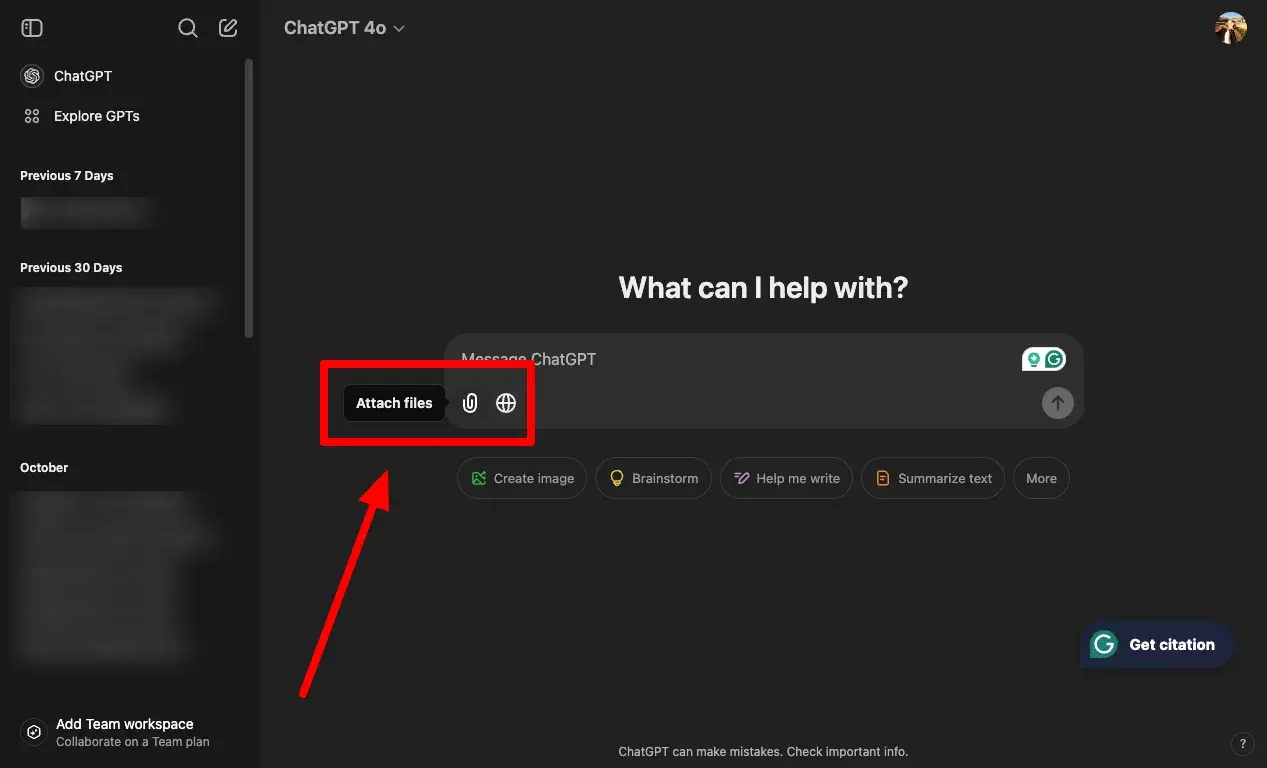
She shares, “Relying on an AI tool to know your voice without any intelligence to go off of but the web will likely result in a tone that isn‘t a fit for you or your brand. When starting a new prompt, I upload documents of past work I’ve written.”
“That way, it can model the format, structure, and tone I want. There's still editorial work to do, but it helps get us much closer to what we’re looking for.”
Share terms and phrases to exclude.
It makes sense to tell your tool what you want, but explaining what you don’t want helps make the parameters even clearer. If there are particular phrases or topics you’d like to avoid (i.e., the name of a competitor), state that in your prompt.
No information is too much when it comes to your AI prompt. While it may take you longer to prepare these details before going into production, you’ll be much more likely to save time editing because of it.
Pro tip: If you’re a HubSpot user, using Breeze can eliminate much of the work involved in prompting.
While Breeze’s inherent purpose isn’t to create “human-like” content, we built it with a particular marketing and sales context in mind that makes it better at doing so.
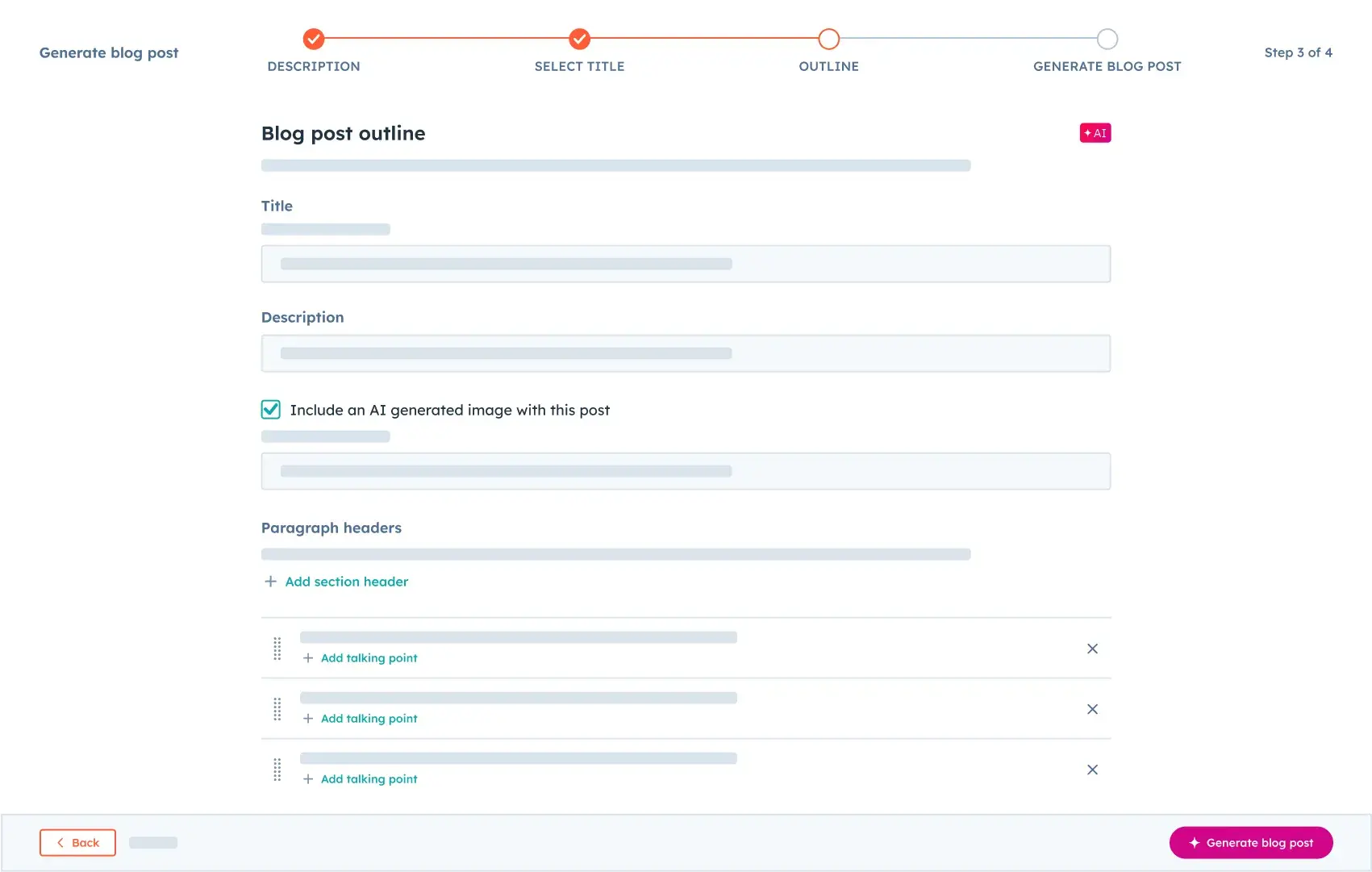
Our team focused on prompt engineering, so the tool knows how to provide more details from your portal about the customer, company, or use case at hand when generating content, even if you don’t specify it in your prompt.
This goes for blog articles, emails, social posts, website copy, and even SMS text messages.
7. Use an AI humanizing tool.
Ok, I know. This is a lot of manual effort. If you don’t have the resources, there are some AI tools dedicated to humanizing content to execute these tasks for you.
In the next section, I’ll share four of the best.
Free AI Content Humanization Tools
Note: These AI tools are not for generating new content but specifically for making the content better.
If you’re looking for tools to create content from scratch, check out our article, AI Content Generators: I Tested 5 of the Best; Here's What I Found.
1. Ahrefs

According to Ahrefs, its AI text humanizer is built on a language model that learns communication patterns, grammar, and vocabulary from text data fed into it.
It then uses that insight to generate human-like text based on what you enter, producing one, three, or five variants at a time. I tried it out with my article from ChatGPT, and here’s what I found.
The good:
- The edits weren’t dramatic, which makes sense since the original article was pretty casual in tone, but the changes it did make were impactful. For example, it changed “Start by understanding who your followers are and what they care about.“ to “Begin by identifying who your followers are and what matters to them.” It’s a small but clarifying edit.
The bad:
- I could only enter about half of the content, meaning there is an undisclosed word or character limit.
- Formatting is removed when you enter text, so you’ll have to reformat it before use.
- The tool detects AI-generated content. It gave me a note at the top of my results that read: “80% of your text is likely AI-generated.” This seems unnecessary because why would you mean “humanizing” your content if AI didn’t write it?
Overall, it is a helpful, easy-to-use free tool, but the user experience could be better. With the undisclosed word limit, it’s also most useful for shorter content needs like website copy, social media posts, or specific passages.
2. Writesonic
Writesonic’s free AI text humanizer works similarly to Ahref’s in that you simply copy and paste your text and hit a button to get results—but with some nice little extras.

The good:
- After entering my text, I could choose from 14 different tones of voice (i.e., engaging, persuasive, friendly, etc.). This option makes the tool that much more useful for a variety of content marketing purposes. Not every tone is right for every campaign or medium and being able to specify what you need definitely makes you feel more confident in the results it will deliver.
- I could also choose from 24 languages, including English, Spanish, Japanese, Swedish, Turkish, and Hindi.
- There is a 200-word limit, and it showed me how many I was over or under. The tool wouldn’t run unless I was under this limit. The transparency of the word count was great to see and doesn’t leave you wondering if you did something wrong like Ahrefs.
The bad:
- I tried two different tones: simplified and luxury. At first, I was fairly impressed. The simplified version definitely removed some more formal language and replaced it with more universal alternatives (e.g., replacing “audience” with “followers”). However, when I switched to “Luxury,” the results were pretty much unchanged.


- Writesonic maintained more formatting than Ahrefs when entered, but it was all removed after editing. This makes it difficult to skim and evaluate the results.
- There were some grammatical issues (i.e., missing commas) in the results.
Regarding UX, Writesonic’s AI text humanizer is a step up from Ahrefs. I appreciate their transparency about the word limit, and the results are decent, but the customization options seem to be more for show at the moment.
I also got hit with a form after my third test generation. You need to sign up to keep using the tool for free.
3. Surfer
Next up, I tried Surfer’s free AI content humanizer, which is currently in beta.

The good:
- Out of the options I tried, Surfer has the highest word limit at 500 — but this appears to be a lifetime limit. Like Writesonic, Surfer is transparent about the limit, so I wasn’t left guessing.
- It maintains and preserves text formatting throughout the humanization process — Huge win! This includes header and paragraph tags.
The bad:
- There are some grammatical issues (i.e., missing commas and inconsistent capitalization) in the results.
- No customization options for tone, language, etc.
- Like Ahrefs, the edits were minimal, with the tool noting that the copy already read as a human wrote it. This is understandable, but if I’m coming to this tool, clearly, I’d like to see it improved further. I’d like to have to seen the tool do more.
4. Scribbr
While not designed as a “humanizer” like the other tools, Scibbr’s free paraphraser tool can used for these purposes in a crunch.

The good:
- I could copy and paste text or upload a document to be paraphrased.
- I could paraphrase in 26 different languages.
- The tool has two modes I could choose from: standard and fluency.
- Toggling the “synonyms” options allows you to control how much of the specific language you’d like to change.
- Preserves most formatting throughout the process.
- Allows you to choose specific words to “rephrase” in the results. When you click on the highlighted word, you can then select the alternative you like best.
- Edits are substantial.

The bad:
- This has the lowest word limit out of those I tested, with a limit of just 125 words.
- With this tool's significant edits, there is a higher risk of losing focus keywords when using this for content marketing.
Master the Balance Between AI and Humanity
As we enter a future where AI becomes an even greater force in content creation and marketing, the key to success is balance.
AI offers incredible speed, efficiency, and scalability, but it’s the human touch — our personal voices, wins, losses, and experiences — that makes content great. It’s what breathes life, personality, and authenticity into your message and builds trust with an audience.
It’s the X factor that makes them want to follow you on social media, buy from you, and recommend your brand.
By blending personal insights, unique examples, careful editing, and more thoughtful prompting, we can create content that resonates deeply with our audiences while leveraging the best that technology has to offer.
